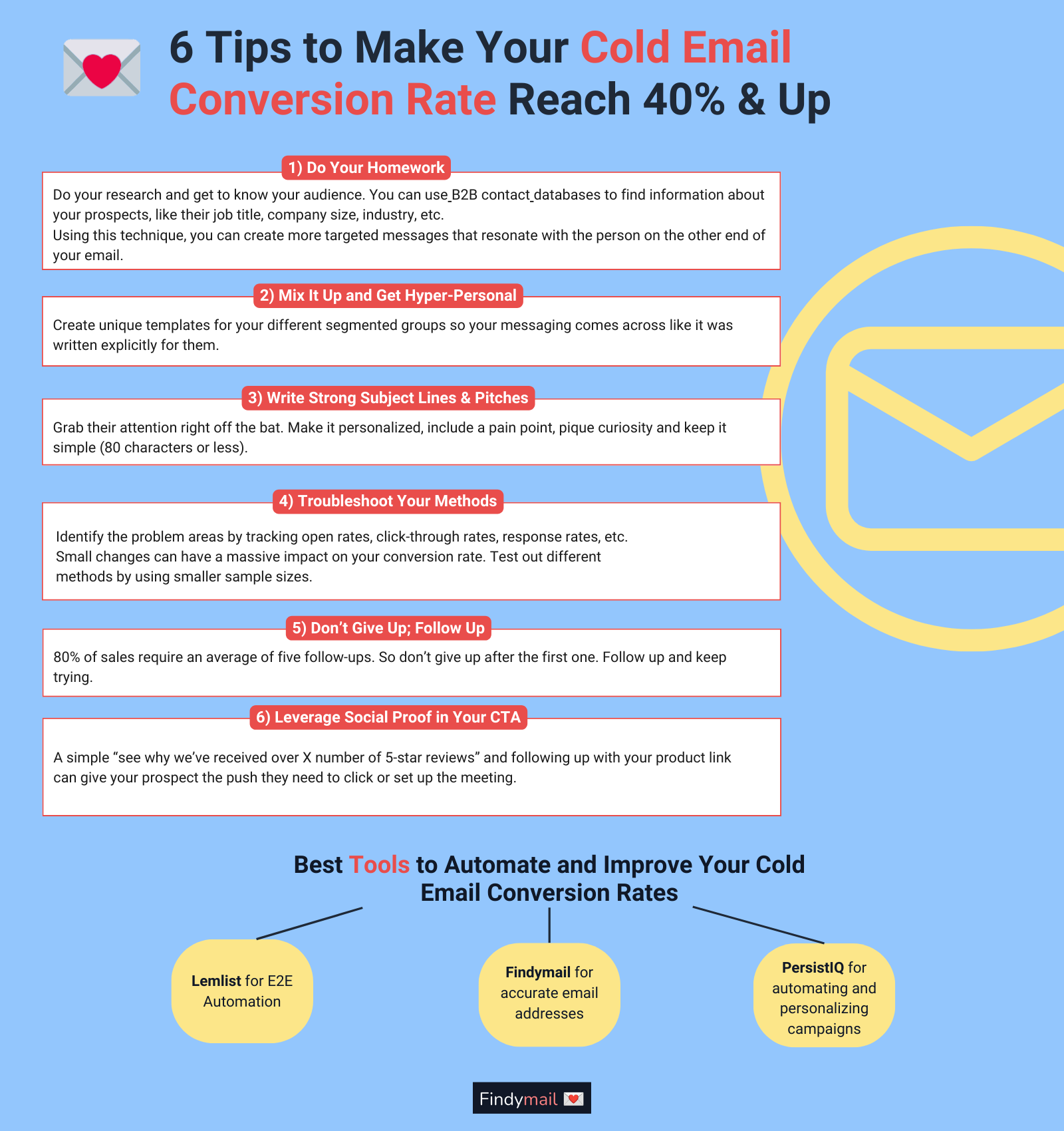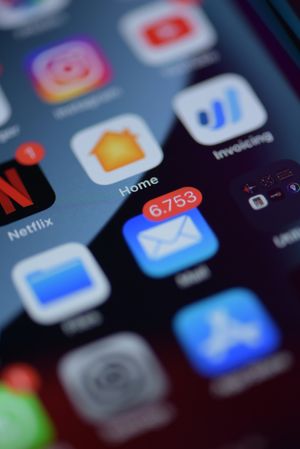If you’re where I was a few years ago, you’re tired of sending cold emails and feeling like you're shouting into the void. However, I didn't give up when my results weren’t brilliant.
I did my research, tinkered with my formula, and finally figured out how to make my cold emails actually work. And the results have been mind-blowing, increasing my cold email conversion rate from less than 10% to 40% and higher.
In this article, I will share some of my secret sauce that helped me regularly see high cold email conversion rates. If you’re in the business of making the most out of every email you send, let’s dive in!
And remember, if at first you don't succeed– cold email, cold email again!
Figuring Out Your Cold Email Conversion Rate
If you’re new to cold email, here’s a quick crash course:
The conversion rate is the number of people who take action from your cold emails– whether that’s replying, setting up an appointment, or buying something from you.
And you figure out the percentage rate by dividing the number of people who take the desired action by the total number of emails sent.
For example, let's say you sent 100 cold emails and received 10 responses, 3 scheduled calls, and 2 purchases.
Your conversion rate would be:
(10 + 3 + 2) / 100 = 15 / 100 = 15%
Of course, it all depends on what results you’re looking for. The rate will be calculated based on what action is considered a successful conversion in your case.
Cold Email Conversion Stats
Now let’s take a look at some stats so you can have an idea of what’s considered bad, average, and good.
If we look at data from Backlinko, which analyzed data from over 12 million email campaigns, they found that only 8.5% of people responded to emails.
However, looking across the web for people’s personal experiences during their campaigns, you’ll see the numbers can vary wildly.
For example, replies on Quora to this question from marketers and business owners say that you should aim for 3-4%.
But as another user points out in a different post, a 2.5% conversion rate on 100,000 contacts is 2,500 new leads.
On the other hand, we can all agree that the goal is to have the conversion rate as high as possible. And when you start hitting numbers like 40%, 50%, and possibly higher, you’re doing something right and getting real results.
So how do we get these stellar numbers? Well, that’s what I’m here to lay out for you.
Let’s take a look at some of the tips and tricks I’ve used to create cold emails that not only get people to open and read them but follow through to the end of my sales pipeline.
6 Tips to Make Your Cold Email Conversion Rate Reach 40% & Up

1) Do Your Homework
Before you write a single line of your cold emails, you need to do your research and get to know your audience. You can use B2B contact databases to find information about your prospects like their job title, company size, industry, etc.
Using this technique, you can create more targeted messages that resonate with the person on the other end of your email.
Also, make sure you’re segmenting your audience according to buyer personas. That way, your emails will be tailored, but you’ll still be able to automate them with cold outreach tools.
2) Mix It Up and Get Hyper-Personal
Don't make the mistake of sending the same thing to everyone. Create unique templates for your different segmented groups, so your messaging comes across like it was written explicitly for them.
Of course, it's easier to send a generic message to as many people as possible. But, as my recent deep-dive into cold email statistics has shown, even just personalizing the subject line increases open rates by 50%.
When you add personalized body copy to the mix, showing your customer that you really understand their pain points, you’ll see a much higher cold email conversion rate.
According to research from LinkedIn, making your emails more personal can increase your conversions by 10%. Of course, you don’t need to write out every single email by hand to achieve personalization.
That’s downright unfeasible if you’re sending out 10,000+ emails. However, using software to hyper-personalize your emails with merge tags can help you tailor your messages to the lead and increase your conversion rate.
Here’s an example from a user on Reddit who has an amazing 59% reply rate:
“Hey/Hello [First Name],
I am [His Name] from [His Company]. It's a digital magazine that provides painkillers to entrepreneurs' problems, and I am its co-founder.
I would like to offer your members three months free subscription to my magazine. It's a digital magazine and your members can download it on their phones and iPads.
If you and I are willing to go ahead, I would be thanking you by writing your coworking space name, [coworking space name], in the partnership section on my website.
Can you and I talk on the phone for 10 mins? I can explain this offer a lot better over the phone.
Best Regards,”
He addresses the reader by name. Then he introduces himself and his company. It shows his value proposition and how it can benefit the specific client - a coworking space.
He then closes it out with a CTA to get the lead to book a meeting. Simple and sweet, and that’s how we like it!
3) Write Strong Subject Lines & Pitches
The subject line is the first thing the person sees when your email hits their inbox.
A poorly-written or spammy-looking subject line can lead to the person ignoring or even deleting the message.
That’s why your subject line needs to be something that grabs their attention right off the bat. My go-to rules are:
- Make it personalized
- Include a pain point
- Be descriptive and pique curiosity
- Keep it simple (80 characters or less)
Let’s look at some examples so you can see what I mean:
- “{{First Name}}, interested in a free demo of our product?”
- “Hey, {{First Name}}, want to {{resolve a challenge, e.g., double the amount of customers you have}}?”
- “{{First Name}}, are you tired of {{pain point}}? Let’s talk.”
See? Simple and direct to the point. I’ve had a lot of success with subject lines like these, and you can too. Don’t overthink it!
4) Troubleshoot Your Methods
You need to understand where your emails are getting stuck and where people drop off. Identify the problem areas by tracking open rates, click-through rates, response rates, etc.
If people aren’t opening your emails, that indicates the issue is with your subject line (see tip #3).
If you’re getting a reasonable open rate, but no one is replying or clicking, your pitch and email body suck.
Small changes can have a massive impact on your conversion rate. Test out different methods by using smaller sample sizes. Try running 3 or 4 smaller campaigns of 100 emails each, which will help you get a better idea of what needs to be switched up.
5) Don’t Give Up; Follow Up
A lot of people send one email and leave it at that. That’s the worst thing you can do because: A) it’s possible they’re interested and didn’t see the first email, and B) it leaves the door open for a competitor to swoop in.
80% of sales require an average of five follow-ups, after all.
I typically send a modified version of my original email after 24 hours. And if I still don’t hear from them within a day or two, I send another highlighting my value proposition and CTA.
So don’t give up after the first one. Follow up and keep trying. I explain how in the follow-up email playbook.
6) Leverage Social Proof in Your CTA
Of course, we all know the CTA is the secret weapon in our back pocket. However, you can make it much more effective by leveraging the power of social proof and case studies.
A simple “see why we’ve received over X number of 5-star reviews” and following up with your product link can give your prospect the push they need to click or set up the meeting.
And depending on your industry, case studies are perfect for showing how other companies have succeeded by partnering with you.
The Best Tools to Automate and Improve Your Cold Email Conversion Rates
While you will need a strategy to boost your cold email success, a good tool is worth its weight in gold. Here are a few of my favorites:
1. Lemlist for E2E Automation
First is Lemlist, a must-have tool for sales and marketing professionals. It comes with various features like personalized templates, automatic follow-ups, and real-time tracking.
Plus, you can segment your lists and integrate with other tools like Salesforce and LinkedIn Sales Navigator.
It makes scaling cold emails a breeze!
2. Findymail for Accurate Email Addresses
Disclaimer: I built Findymail because I was tired of inaccurate email addresses from other tools constantly wrecking my deliverability.
Findymail works as an app, API, and Chrome extension, so you can:
- Use it to verify email addresses in your lead gen lists
- Export and automatically find email addresses for your Sales Navigator and Apollo leads:
It’s quick, easy to use, and you only pay for verified email addresses!
3. PersistIQ
PersistIQ is a sales engagement platform that automates and personalizes your cold email campaigns. You can create personalized email templates, schedule follow-up sequences, and track engagement in real-time.
As I mentioned, there are tons of cold outreach tools, but these three are great jumping-off points that I can personally vouch for.
Key Takeaways
I understand it can be discouraging to send thousands of emails and only get a few responses. But if there’s one thing I want you to take away from this article, it’s this: personalization is critical.
When you use personalization as a basis for coming up with cold outreach strategies, you’ll see tremendous success. And this goes beyond saying the lead’s name – you must figure out their pain points and offer the right solution.
Now that you have these crucial tips in mind, get out there and start killing it with your cold emails!






